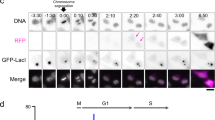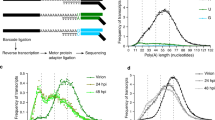Abstract
INHIBITION of protein synthesis decreases the rate of DNA synthesis in both prokaryotes and eukaryotes. In prokaryotes, DNA synthesis is dependent on protein synthesis only for the initiation of replication1. In the case of eukaryotes, reduction of DNA synthesis occurs rapidly after the inhibition of protein synthesis2,3, although the mechanism of the tight coupling between protein and DNA synthesis is unclear. The DNA which is synthesised at a reduced rate in these conditions is basically normal except that the elongation step seems to be modified2,3. Newly replicated DNA synthesised in the presence of cycloheximide seems to be associated with less chromatin protein, because chromatin synthesised in these conditions is more susceptible to digestion by DNases3,4. T antigen of simian virus 40 (SV40) is a product of the A gene of the virus5 and has been shown to have a role in the establishment and maintenance of transformation6–9. There is evidence that T antigen is required for the initiation of viral DNA replication10 and the induction of synthesis of cell DNA11–15. It has also been suggested that T antigen initiates DNA synthesis in transformed cells and thereby serves to retain those cells in the transformed state10,16–18. Recently, T antigen was purified almost to homogeneity, and its microinjection into quiescent mouse cells induced DNA synthesis19. However, the mechanism of action of T antigen in cell DNA synthesis remains to be clarified20. If T antigen acts on cellular DNA synthesis, SV40-transformed cells which contain T antigen may behave differently from other cell lines in their ability to continue DNA synthesis in conditions of protein synthesis inhibition. We report here that DNA synthesis in SV40-transformed cells continued at an almost normal rate while protein synthesis was inhibited by cycloheximide, whereas DNA synthesis in malignant tumour cells without T antigen did not continue in these conditions.
This is a preview of subscription content, access via your institution
Access options
Subscribe to this journal
Receive 51 print issues and online access
$199.00 per year
only $3.90 per issue
Buy this article
- Purchase on Springer Link
- Instant access to full article PDF
Prices may be subject to local taxes which are calculated during checkout
Similar content being viewed by others
References
Hanawalt, P. C., Maaløe, O., Cummings, D. J. & Schaechter, M. J. molec. Biol. 3, 156–165 (1961).
Weintraub, H. & Holtzer, H. J. molec. Biol. 66, 13–35 (1972).
Searle, R. & Simpson, R. J. molec. Biol. 94, 479–501 (1975).
Weintraub, H. Cell 9, 419–422 (1976).
Tenen, D. G., Baygell, P. & Livingston, D. M. Proc. natn. Acad. Sci. U.S.A. 72, 4351–4355 (1975).
Martin, R. G. & Chou, J. Y. J. Virol. 15, 599–612 (1975).
Tegtmeyer, P. J. J. Virol. 15, 613–618 (1975).
Brugg, J. S. & Butel, J. S. J. Virol. 15, 619–635 (1975).
Osborn, M. & Weber, K. J Virol. 15, 636–644 (1975).
Tegtmeyer, P. J. Virol. 10, 591–598 (1972).
Chou, J. Y. & Martin, R. G. J. Virol. 15, 145–150 (1975).
Fox, R. O. & Levine, A. J. J. Virol. 7, 473–477 (1971).
Gershon, D., Sachs, L. & Wincour, E. Proc. natn. Acad. Sci. U.S.A. 56, 918–925 (1966).
Henry, P., Black, P. H., Oxman, M. N. & Weissman, S. M. Proc. natn. Acad. Sci. U.S.A. 56, 1170–1176 (1966).
Smith, H. S., Scher, C. D. & Todaro, G. J. Virology 44, 359–370 (1970).
Martin, R. G., Chou, J. Y., Avila, J. & Saral, R. Cold Spring Harb. Symp. quant. Biol. 39, 17–24 (1974).
Martin, R. G. & Oppenheim, A. Cell 11, 859–869 (1977).
Oppenheim, A. & Martin, R. G. J. Virol. 25, 450–452 (1978).
Tjian, R., Fey, G. & Graessmann, A. Proc. natn. Acad. Sci. U.S.A. 75, 1279–1283 (1978).
Levine, A. J. Biochim. biophys. Acta 458, 213–241 (1976).
Todaro, G. J., Green, H. & Swift, M. C. Science 153, 1252–1254 (1966).
Sheinin, R. & Humbert, J. A. Rev. Biochem. 47, 277–316 (1978).
Henderson, I. C. & Livingston, D. M. Cell 3, 65–70 (1974).
Pope, J. H. & Rowe, W. P. J. exp. Med. 120, 121–131 (1964).
Carroll, R. B., Hager, L. & Dulbecco, R. Proc. natn. Acad. Sci. U.S.A. 71, 3754–3757 (1974).
D'Alisa, R. M. & Gershey, E. L. Nature 274, 164–166 (1978).
Elgin, S. C. R. Meth. Enzym. 15, 144–160 (1975).
Lowry, O. H., Rosenbrough, N. J., Farr, A. L. & Randall, R. J. J. biol. Chem. 193, 265–275 (1963).
Author information
Authors and Affiliations
Rights and permissions
About this article
Cite this article
IDE, T., OHTA, T., SHINOHARA, Y. et al. Persisting DNA synthesis in SV40-transformed cells in the presence of cycloheximide. Nature 278, 264–265 (1979). https://doi.org/10.1038/278264a0
Received:
Accepted:
Issue Date:
DOI: https://doi.org/10.1038/278264a0
This article is cited by
Comments
By submitting a comment you agree to abide by our Terms and Community Guidelines. If you find something abusive or that does not comply with our terms or guidelines please flag it as inappropriate.



